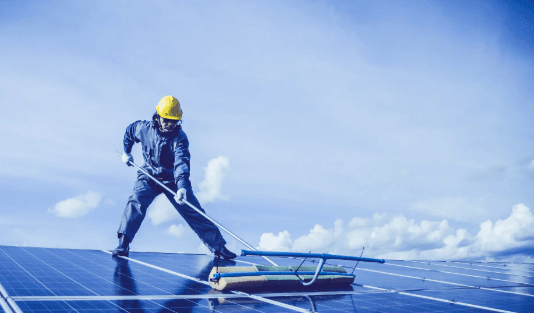Solar panels are light collectors. When they’re covered in dust, pollen, ash, salt spray, or bird fallout, they simply collect less light — and you get less power. Routine, gentle washing restores clarity, keeps warranties happy, and protects your investment for the long run.
The Payoff: Performance, Protection, and Payback
More energy, more savings: Clean glass = better light transmission and measurable output gains.
Longer life: Removing corrosive debris (bird droppings, salt, ash) prevents etching and hot spots.
Healthier system: A clean visual baseline makes it easier to spot cracked glass, failing gaskets, or loose wiring.
Better monitoring data: If panels are dirty, performance alerts are noisy; cleaning brings your baseline back to normal.
What “Power Washing” Should Really Mean
Please don’t hit panels with a high-pressure tip at close range. That’s a great way to force water into seals, scratch the glass, or void a warranty. Professional solar cleaning = low pressure + pure water + soft contact.
Our best-practice approach:
Low-pressure rinse (fan tip, not a needle) to float off grit.
Deionized (DI) water or RO-filtered water to avoid mineral spots.
Non-abrasive brush or pad on a water-fed pole — no scouring.
No soaps that leave residue (they attract dirt).
Final DI rinse for a spot-free dry.
Pro tip: If you must use a cleaner, choose a manufacturer-approved, non-ionic detergent and rinse thoroughly.
Safety First (Always)
Electrically live equipment: Panels and wiring can be energized in daylight. We clean from safe positions, avoid junction boxes, and never lift frames.
Roof safety: Tie-off, walk pads, and edge protection prevent both slips and shingle damage.
Timing: Early morning or evening, when modules are cool, prevents thermal shock and flash drying.
How Often Should Panels Be Cleaned?
Baseline: 1–2 times per year for most homes.
More often if: You’re near farms (dust), freeways (film), the coast (salt), trees (pollen/sap), or wildfires (ash).
After events: Post-windstorms and heavy pollen drops are prime times for a rinse.
Signs It’s Time
Visible haze or streaks that don’t flush off with rain
Bird droppings or sticky spots that shade individual cells
Noticeable dip in production vs. your typical seasonal numbers
Splash lines from sprinklers or hard-water spots
Why DIY Often Falls Short
Hard water = spots. Tap water leaves mineral films that scatter light.
Wrong tools scratch. Household scrub pads or gritty brushes can damage the glass coating.
Pressure risk. Consumer pressure washers can breach seals and invite leaks.
Roof hazards. One slip isn’t worth a few cents of kilowatt-hours.
Our Pro Cleaning & Checkup (Fast & Warranty-Friendly)
Visual inspection: Frames, glass, wiring, mounts, and roof penetrations.
Gentle wash: DI water, soft pads, low pressure — no residue.
Spot treatment: Safe removal of baked-on debris and bird fallout.
Rinse & dry: Spot-free finish.
Documentation: Before/after photos and notes for your records (and warranty files).
Add-On Services That Make Sense
Critter guards around arrays to keep birds and rodents out.
Vegetation trimming for shade reduction.
Array wash + gutter clean combo before storm season.
Production check (if you share inverter/app access) to confirm gains post-clean.
Ready to Get Your Watts Back?
A professional, low-pressure cleaning can boost performance, protect glass and seals, and keep your warranty intact. Book a solar panel wash and checkup and we’ll handle the safety, the shine, and the proof.
Does rain clean solar panels?
Rain helps with loose dust, but it often dries into a film. Stuck debris (pollen, ash, droppings) needs a proper rinse and soft brushing.
Will high-pressure washing damage panels?
It can. Excess pressure may compromise seals, force water into junctions, or scratch glass. Use low pressure and DI water.
Do soaps improve cleaning?
Residue attracts dirt. If needed, use a manufacturer-approved, residue-free cleaner — and rinse thoroughly with DI water.
When will I see results?
Immediately. Most homeowners notice improved production on their monitoring app the same day, weather permitting.
Can I clean panels while they’re hot?
Avoid midday heat. Clean mornings/evenings to prevent thermal stress and streaking.

